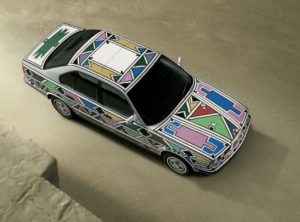
Esther Mahlangu in front of her house in Middelburg, province of Mpumalanga, South Africa, 2016. Photo courtesy of BMW
Esther Mahlangu’s presence is striking, like her art. The 80-year-old South African artist wears the traditional dress of her Ndebele heritage: thick, beaded necklaces; gold bangles, chokers, and ankle bracelets; patterned head adornments stitched together from hundreds of beads; and voluminous textiles in vibrant colors wrapped around her body. She could step right into one of her vivid murals or wall-size paintings, which similarly stop you in your tracks.
Mahlangu’s work speaks a visual language that spans disciplines, from pop art to graphic design. She imagines her compositions without the help of preliminary drawings, and, with superhuman precision and using a delicate chicken feather as her brush, she applies thick black lines in patterns that echo Ndebele beadwork but in paint, then adds swathes of rich color.
“I always watched my mother and grandmother when they were decorating the house,” says Mahlangu of her start in painting. “The original patterns that were painted on the houses in the past were part of a ritual of Ndebele people to announce events like a birth, death, wedding, or when a boy goes off to the initiation school. I started painting on canvas and board as I realized not everybody will be able to see the Ndebele painting in Mpumalanga where I live, and I felt I need to take it to them to see. This is how my work started to be exhibited in museums and galleries around the world.”
While Mahlangu’s artistic foundation is in the centuries-long tradition of Ndebele craft, she has developed a visual lexicon and color palette that is specific to her.
“In the old days, the decoration on the houses was always done with natural pigment and cow dung as that was the only material available,” she remembers. “We were very limited with colors and used monochromatic yellow, white, ochre, black, and red clay. Then acrylic paint in lots of colors was introduced, which was more durable in the rainy season and it was adopted by the younger generation of painters like myself.”
For her breakout exhibition, in the group show “Magicians of the Earth,” at the Centre Pompidou in 1989, Mahlangu used acrylic paint.

Esther Mahlangu’s 1991 BMW Art Car. Photo courtesy of BMW.
“The Ndebele started using the colors and patterns that Mahlangu plays with now only around the 1940s, around the time when Esther was born,” says Thomas Girst, an art historian, author, and Head of Cultural Engagement at BMW.
The company recently commissioned the artist to paint the interior panels of a BMW Individual 7 Series, 25 years after they asked her to paint their 1991 BMW Art Car. That early commission was the first of the series’ collaborations with women.
“She was trying to blend tradition with modernity, so while there is a family trajectory there, it was also her and her generation who took this one step further, making this now-recognized Ndebele contribution to contemporary art,” added Girst.
Read more here


